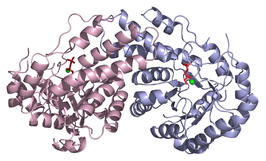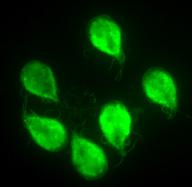| A genomic approach combined with biological insight has been taken to identify enzymes essential for the survival of the organism, which are absent or are sufficiently divergent from the human enzymes to exploit those differences in the design of inhibitors. Enzymes that are aldolase II structurealdolase II structure produced in soluble form are validated in G. lamblia by transcription interference methods. Essential enzymes are charachterized structurally and functionally. The crystal structures serve to guide the design of inhibitors specific to the Giardia enzymes, and structures of complexes further inform inhibitor optimization. The long range goals of the project is to establish a database of potential drug targets against giardiasis, to gain insight into their mechanism of action, and to prepare inhibitors that are ready for preclinical evaluation. | 
|


